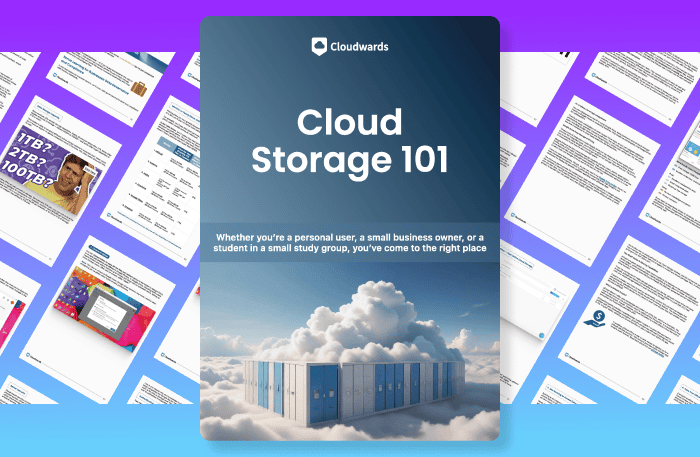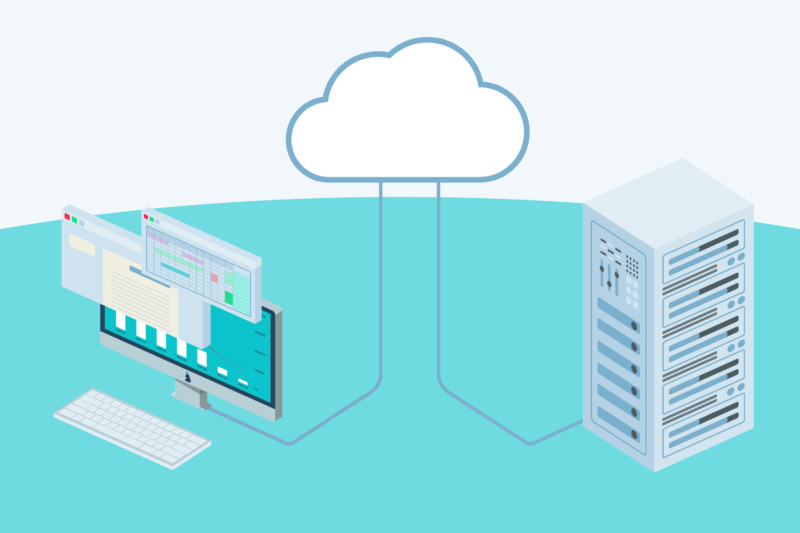Cloud Storage vs Online Backup: What’s The Difference in 2025?
The debate between cloud storage vs online backup is one in which you don’t need to declare a winner. Each of them serves a purpose, and you might need both, depending on your backup plan. Read on to see what cloud storage and online backup do and how to utilize them to the fullest.
Cloud storage and online backup are very similar types of software that are often confused with each other. Although they look similar at first glance, each serves a very different purpose. In this article, we’ll attempt to clear up all the ambiguities in the comparison between cloud storage vs online backup.
Cloud storage is mainly concerned with storing your files and allowing for easy access, sharing and collaboration. On the other hand, online backup mostly keeps your files safe in a form that lets you restore them in case of a disaster. However, there’s much more to it than that, so read on for the full picture of what cloud storage and online backup are and how they differ from each other.
-
05/20/2022 Facts checked
Rewrote this article to provide more up-to-date information.
-
10/18/2024 Facts checked
Added new video explaining the difference between online backup and cloud storage.
Cloud Storage vs Online Backup: What Is the Cloud?
In the broadest terms, the cloud is a place on the internet that stores digital data and allows you to access it. However, while you might immediately connect that definition to a cloud storage service like Dropbox, it is also precisely this concept that allows the internet to function the way it does.
At its core, the internet is simply a network of computers that can communicate with each other. Any online service that gives you access to data that’s stored remotely is using the cloud in some capacity.
10,000+ Trust Our Free Cloud Storage Tips. Join Today!

- Demystify cloud storage terminology and key concepts in plain language
- Discover easy-to-implement techniques to securely backup and sync your data across devices
- Learn money-saving strategies to optimize your cloud storage costs and usage
Think of it this way: All websites need to store their data somewhere. While they could host the data themselves in one centralized location, the vast majority of websites use third-party servers, usually via the Amazon AWS, Microsoft Azure or Google Cloud platforms. This means that most websites on the internet run on cloud technology.
The best example of the parallels between the internet and the cloud is social media. Social media platforms draw many similarities to cloud technology because they store your photos or text posts online, letting you access them from wherever you are, yet you wouldn’t think of Facebook as cloud storage.
Where Do Cloud Storage and Online Backup Fit Into This Story?
As we said earlier, the internet and the cloud are two interconnected concepts that largely overlap due to the way we currently use the internet. Thankfully, cloud storage and online backup use the cloud in a much more straightforward way, by simply storing your files there.
The main difference between the two types of cloud tech is what each of them does with your files and how it lets you interact with them. Coming up, we’ll look at the specific features of cloud storage and features of online backup to highlight what makes them different from each other.
Features of Cloud Storage Services
The main goal of cloud storage services is data portability and accessibility. In other words, cloud services let you upload files to the cloud and access them from anywhere with an internet connection.
However, there’s much more to cloud services than that. Having your files in the cloud where they’re easily accessible opens up a whole world of possibilities.

Access Files From Anywhere
Unlike your computer, the cloud doesn’t have a physical location. This means that you can access it wherever you are, on any device you like, as long as that device is connected to the internet.
With cloud storage, you no longer need to carry your files around on a USB stick, or even lug a laptop around for work. This is great if you’re a remote worker, because it means you can work from anywhere, on any device you like, and you’ll still have those files available on your office device.
File Syncing
One of the ways cloud storage enables remote access is via file syncing. If you have a cloud storage app installed on several different devices, the app will keep an identical copy of your files on all your devices. Any time you make a change to one of the files, the file is immediately updated everywhere.
Cloud sync goes a long way toward improving accessibility because the files get downloaded to your computer and you don’t need an active internet connection to access them. This is useful for when you’re somewhere with no internet access, which can be an issue when you’re traveling. File syncing also lets you automatically upload photos you take on your phone to the cloud.
Sharing Files
Another great thing about cloud storage is that with your files already in the cloud, it’s incredibly easy to share them. You can simply create a sharing link to your file or folder to let other people see or download it. This feature also creates novel ways of collaboration.
Some services, like Sync.com, offer advanced sharing features, like password-protected sharing links, expiry dates, download limits and permission-setting. Read our article on the best cloud storage for sharing if that piques your interest.
Productivity and Collaboration
Because it’s so easy to share cloud-based files, collaboration and productivity have become a highlight of many cloud storage services. These collaboration features usually come in the form of advanced sharing settings that let you give editing permissions to other people, but there’s much more to it.
Some of the larger players, like Google and Microsoft, have their own document editing suites in the form of Google Workspace and Microsoft Office. Their cloud services — Google Drive and Microsoft OneDrive — are tightly integrated with these productivity suites and let you create and edit documents within your cloud storage.
Other cloud storage solutions, like Dropbox and Sync.com, also integrate with these document editors, via third-party links. Some cloud storage services even have their own add-on stores for integrations with other apps, like PDF viewers or even 3D modeling software.
Features of Online Backup Services
The first thing you’ll notice about online backup (or cloud backup) is the lack of access you have to files. There are exceptions, of course, but cloud backup services generally don’t let you access files remotely. Instead, you upload files on a schedule, and you can later restore your files in case you lose them.

Given the dearth of extra features compared to cloud storage, you might be quick to dismiss online backup as inferior to cloud storage. However, that’s far from the case. Cloud backup services simply have a different purpose, and that’s disaster recovery. Cloud storage providers just can’t match online backup in this area.
Data Recovery
Because data recovery is the focal point of cloud backup software, most backup features revolve around enabling it. If your computer breaks, your hard disk fails, you get a ransomware infection or even if a tornado rips through your house, a cloud backup will let you restore all your important files.
An important part of a good data recovery strategy is to back up your files at regular intervals. This could be once a month, once a week, every day, or even hourly or continuously if you have important files that you edit very often.
However, you wouldn’t want to back up your entire computer every time. To that end, some cloud backup solutions offer block-level uploads and only upload new files and the parts of old files that have changed since the last backup (not the entire file).
File Versioning
Another data recovery tool is versioning. Although cloud storage also has versioning, it’s especially pertinent for online backup services. Versioning lets you keep previous older versions of files or deleted files, so you can restore them if you ever need them. CrashPlan and Backblaze have versioning for up to a year.
If your files get infected with malware or ransomware, they will get uploaded to the cloud in their infected state. Because backup software is frequently used to recover from ransomware attacks, it’s important to be able to restore a previous version that isn’t affected by malware.
Advanced Backup Tools
Cloud backup providers can come with all kinds of features that let you tailor the backup process to your needs. Most important are the ones that allow for special kinds of backups.
For example, image-based backups let you back up your computer’s entire storage, operating system and file system structure. Some services, like IDrive, even let you restore the image to another device without needing to install an OS to it. There is also CloudAlly, a service that lets you backup data that’s already in the cloud — it’s particularly useful if you want an extra layer of protection to your files.
Of course, you can also back up on a per-file basis, or go by drives. If you don’t want to back everything up, you can set exceptions, like disabling backups for system files, or excluding certain types of files.
You can schedule an automatic cloud backup to happen every month, week, day, hour or continuously (different services will have different options), depending on how often you edit your files.
You can choose to back up to the cloud, or to an external or internal hard drive, or both (known as hybrid backup). Some backup services even let you back up entire servers or NAS devices.
Unlimited Storage
Cloud storage providers rarely offer unlimited storage capacity. Some business cloud storage services offer it, but it’s a real rarity in the cloud storage world.
On the other hand, online backup services — Backblaze, for example — very often have unlimited storage plans. This is important because you might need to keep several versions of your device’s entire storage, or even the storage of multiple devices on there.
Final Thoughts
We hope this guide has helped you understand the difference between cloud storage and online backup. In the end, although they both use the cloud to store data, each of them plays a different part in your cloud backup strategy. You might want to use one or the other, or simply use both.
To further see how cloud storage and online backup differs, check out our articles that compare providers such as Google Drive vs IDrive.
Do you use cloud backup or cloud storage? Which one is better for your needs? Would you use both of them at the same time? Let us know in the comments below, and as always, thank you for reading.
FAQ
The terms online storage and cloud storage are nearly synonymous. Everything that is stored online is technically cloud storage, but the term “cloud storage” also refers to a specific kind of software that offers many features beyond storage.
Yes, a cloud backup is stored online, in what’s called “the cloud,” though cloud backup software can also create a local backup, or back up your files to an external hard drive.
Cloud storage gives you quick, remote access to the files you store online, while cloud backup creates a copy of your files online, which you can restore to your device in case of disaster.


